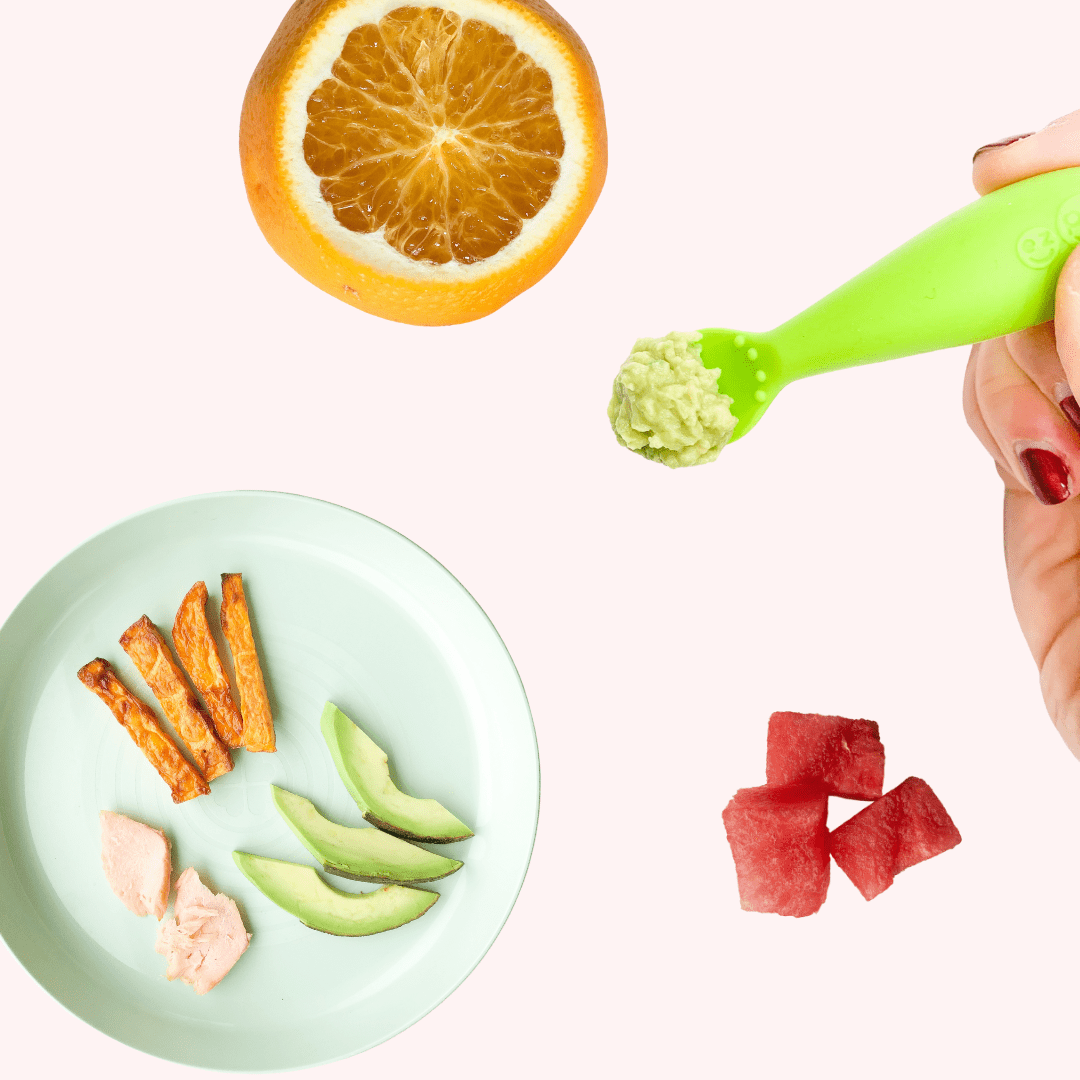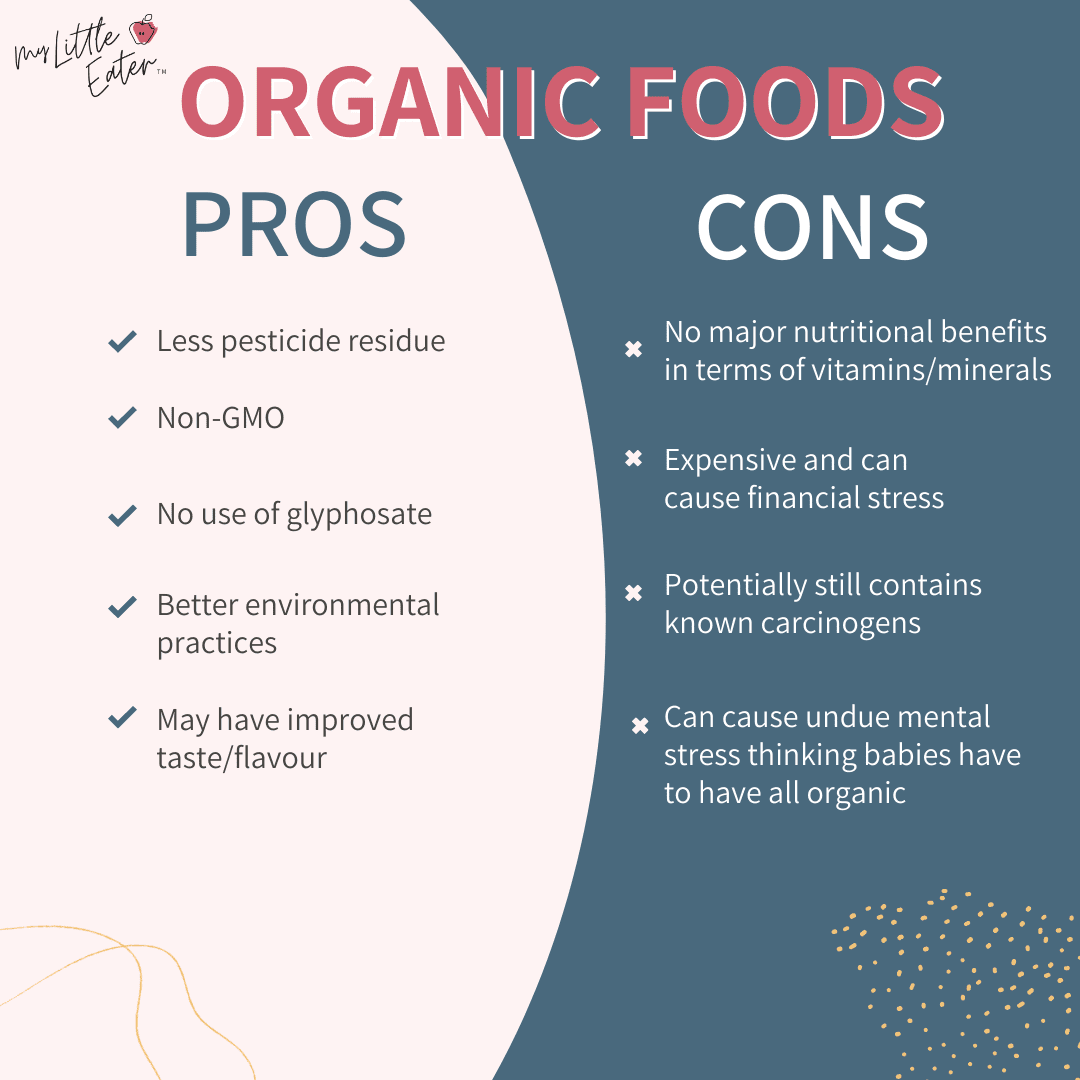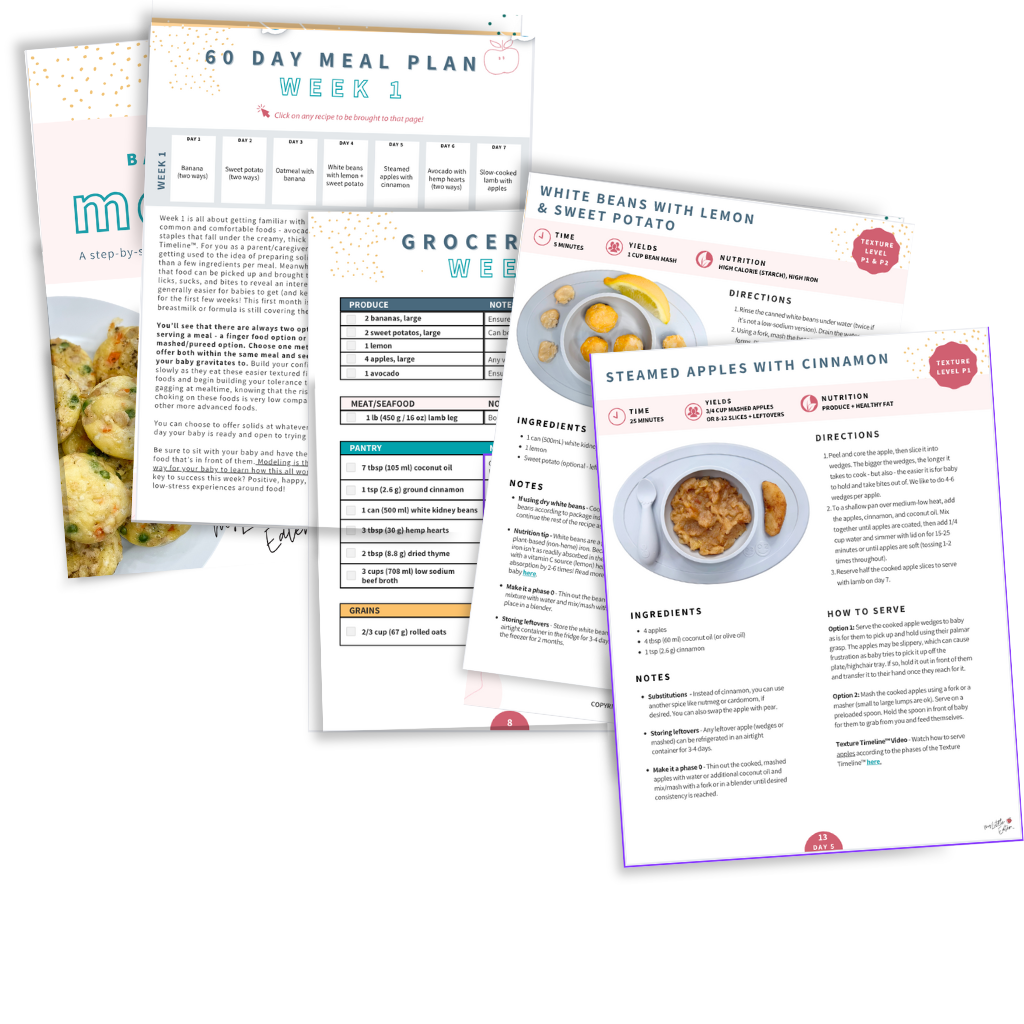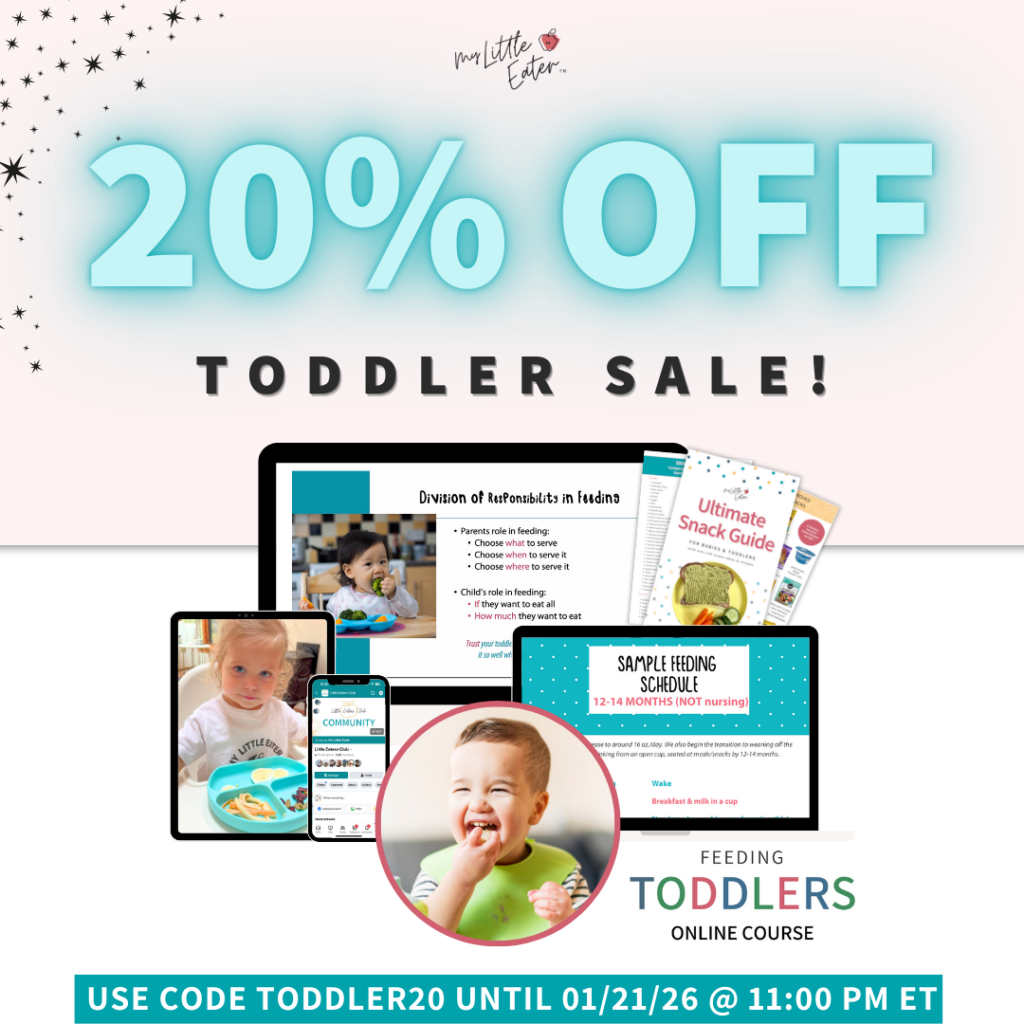
We see the labels, and hear about it so often, that we automatically assume that we have to buy our babies and toddlers organic food…or at least that we’re doing better by them if that’s what we exclusively give them. When you walk down the baby food aisle, you see many, if not most, of the packages tout the organic label, and soon enough the impression that babies have to have organic food is all that you know in your mind.
But, you know me. I like to know the research behind everything! So I’d say it’s always helpful to know why there’s such a push for organic food for babies, and even to question…is it actually better?
One of the top comments that comes up when talking about organic food is the price. We know it’s more expensive, and that not everyone can afford it, or has access to it, so how much of a priority should we make it in our budget? Should we worry if our baby is NOT getting organic food all the time, or even sometimes?
This is what I want to go over today, and if you prefer to listen, download the audio of this discussion and listen when you have a minute.
What’s the difference between organic vs. non-organic food?
Organic foods are ones that are grown with no synthetic fertilizers, or pesticides, and without the use of any GMO’s (genetically modified organisms). Organic is based on a type of farming that is natural, and that helps replenish nutrients and fertility of the soil that the food is grown in, in an environmentally friendly way (1). There can still be pesticides used on the crops (which include herbicides, insecticides, and fungicides that are used to protect their crops from molds, insects, and diseases), but they can only use repellents that are found in nature (also known as biological pesticides) (2).
When something is “certified organic” that means that it’s been grown, handled, and produced according to strict standards enforced by third party organizations that regulate this kind of thing (3). Now, not all natural pesticides are harmless (for example, arsenic and sulfur would be considered natural, but can be harmful in certain doses) and so many are banned from being used, or can only be found in trace amounts that are deemed to be safe.
So how does this differ from conventional or non-organic foods? Well, conventional farmers use man-made, synthetic pesticides. When farmers spray any pesticides, this can leave residue on the produce or crops that we eat. According to the USDA, organic produce carries significantly fewer pesticide residues than conventional produce does.
What’s the risk of consuming pesticide residues, and is it worse for babies and toddlers?
What’s important to note is that…no matter what the pesticide is, your risk depends on the toxicity of the substance, and the amount of exposure. So, you can be harmed, or experience negative health effects from toxic amounts of a pesticide by consuming, or being exposed to, very high amounts over a short period of time (AKA acute overexposure), and in those cases you could experience things like poisoning, or it could result in some long-term effects, such as cancer or reproductive issues. You can also have lower, cumulative dose exposure over a long period of time, which has been associated with health issues such as respiratory problems, skin conditions, depression, birth defects, cancer, and neurological disorders such as Parkinson’s disease (4).
As with my in-depth discussion of mercury in fish for babies and toddlers, infants and children, as well as pregnant and nursing mothers, are extra sensitive and at an increased risk of experiencing negative health effects from exposure to pesticides in food. Exposure during the development of a baby and young child, for example, can be particularly dangerous, affecting hormone regulation and brain development.
How are pesticide levels controlled?
Health Canada, the EPA (Environmental Protection Agency), the EU (European Union), etc. have set strict levels with regards to the amount of pesticides that can be used on both organic and non-organic crops, to ensure they are within the limits of safe consumption for humans. Levels of pesticides considered safe to human health, are determined based on the toxicity of the pesticide, and these levels are called Maximum Residue Limits (or MRLs). In Canada for example, Health Canada scientists have to study and examine products before they’re approved to make sure that they are within these MRLs (5). It’s claimed that these MRLs are set at levels that are far below the amount of pesticide residue that could cause health concerns, and they do take into account the entire population (so that includes infants, children, and pregnant women) (5).
Here’s the thing though, MRLs aren’t necessarily set at the same level across different countries.
Maximum Residue Limits for pesticides on food are generally weaker in Canada than the standards established by the U.S., the European Union, and Australia (6). In Canada, the default is set at 0.1 ppm, which is less restrictive than the default level of 0.01 ppm in other countries (7). MRLs in the EU can even be set lower than 0.01 ppm for substances identified with “exceptionally high toxicity”. In Australia, they sometimes don’t allow any detectable level of pesticide residue if there hasn’t been an MRL set for that pesticide/crop combination. So basically, if there’s been no testing…it’s not allowed. As you can see, some pesticides can be banned altogether in one country, while still being used in others. Since organic foods generally have fewer accepted pesticides allowed, and stricter standards, this is definitely something to consider when deciding if, based on where you live or purchase from, buying organic is a priority for you.
While MRLs are there to set limits and protect us, especially our kids, there have also been problems reported with the fact that not all products are being tested regularly enough. The USDA states that it has a focus on testing foods most likely eaten by infants and children, although no foods are actually tested on an annual basis. For example, baby food was last tested in 2013, and baby formula was last tested in 2014. Additionally, some pesticides are not tested, such as Glyphosate, despite being the most widely used pesticide in the U.S.
And here’s where I want to talk a little more about the controversial topic of Glyphosate, because it’s important you know about it and you’ll probably hear a lot about it at some point, if not already. Glyphosate is the active ingredient in the herbicide Roundup, it is the most widely used pesticide in the U.S and beyond, and is much more of a concern in conventional crops as compared to organic. It’s heavily sprayed on many crops, but especially on soybeans, corn, cotton, and canola that were genetically engineered to resist Glyphosate (8). High levels of Glyphosate can also be found in several grains and beans, such as oats and chickpeas.
Now, as with many pesticides, the health effects of low-dose, chronic exposure to Glyphosate through food, aren’t fully understood. But some research points to the suggestion that Glyphosate is linked with a risk of non-Hodgkin’s lymphoma, as well as liver and kidney problems, and that it disrupts the body’s hormone systems. The EPA says that again, the amounts of Glyphosate allowed on food aren’t harmful, though it is listed as a possible carcinogen by the WHO (World Health Organization). Some argue that the tolerance levels set by the EPA might be too high, and again, when considering the consumption of it by vulnerable populations like pregnant women, babies, and children, it’s definitely questionable, and I can’t deny that especially with the fact that they’re not actually testing for Glyphosate at all, doing what’s reasonable to avoid it makes sense. For example, in 2018, the EWG (Environmental Working Group) tested higher levels of Glyphosate than what’s considered safe for children in almost ¾ of popular oat-based baby and toddler foods (9). So again, it’s definitely something to be aware of.
So, should you choose organic?
Well…like with anything, we’ve got to weigh out the pros and cons.
Generally, research doesn’t show that organic food provides major nutritional benefits over non-organic food. You won’t notice a difference in how your child grows, or the amount of vitamins or minerals that they get. Some research has found higher levels of phenolic compounds (ie. antioxidants), and certain vitamins in organic produce (10). That being said, the studies have been short term, observational, and unreliable. If there’s a benefit of eating organic, it can take much longer to surface, and so, as with most things, more research is required. Basically, it’s really hard to say whether there’s a benefit or not if you haven’t tested it thoroughly.
Organic fruits and vegetables have smaller amounts of pesticide residue than produce that was grown conventionally. So that’s a point for organic. But…as mentioned before, the residues on food — both organic and non-organic — don’t exceed government safety thresholds (except for Glyphosate which we can argue that it might, or does, as it’s not being tested, which is something to consider especially when feeding your baby). Even with organic foods, there is no difference in arsenic and cadmium levels found when compared to non-organic foods – and these are both known carcinogens. So just because something is organic, doesn’t mean that it protects you from all the potentially harmful residues out there.
Organic foods are more expensive than non-organic foods. This is partly due to the cost of natural fertilizer and labor-intensive farming practices. But this may be important to certain families who are concerned, and want to support environmentally friendly practices.
Finally, some people notice a difference in the flavours or taste of organic foods vs. non-organic foods. So for example, they can notice a difference in the taste of an organic strawberry vs. a non-organic strawberry.
At the end of the day, here’s what I want you to know:
- Every single thing we eat, and put in or on our bodies, has a good and a bad side, depending on the quantity, frequency of consumption, and realistically, how hard we look into it (everything has a good and bad if you research it enough).
- Fruits and vegetables are healthy in and of themselves, and avoiding buying produce altogether because it’s not organic is not the answer, and can lead to worse health outcomes.
- Buying organic has benefits for many families who have the means to think about this kind of thing. It can be a way to level up the health of an already healthy diet, and it makes sense to think about it if it’s within your means.
- Buying organic is a detriment for many families for whom this decision causes mental stress, or financial difficulty. The negative effects of strained family dynamics, financial hardship, or lack of time and energy to buy and prepare organic foods are worse for you, and your child’s health, than the potential benefits of organic food.
- Any decision you make is always going to be the right one for you and your family. It says nothing about how much you love your child, whether you prioritize their health, or whether you are a good parent.
Some practical things you can do to find balance:
- Wash fruits and vegetables very well with a produce scrubber. This can significantly reduce pesticide residue, even if you feel it’s already washed well with water, use a scrub brush to remove more residue.
- If all-organic is not feasible (which let’s be real, it’s not for me…it’s not for most), then even replacing some conventionally produced foods with organic will have benefits. Focus on just purchasing organic for the bottom 15 foods from the EWG 2021 shopping guide (see list below). Focus on purchasing only organic oat and wheat based products like infant cereal, rice rusks, rolled oats etc. in the first year of life.
- Choosing frozen organic fruits and veggies is more feasible for many families as they tend to be a better price, and keep for months in the freezer.
- Buying fresh organic fruits & veggies when they’re in season, and then subbing them for something else when they’re out of season, is another way to help with costs.
EWG’s 2021 Shopping Guide
The EWG’s Shopper’s Guide to Pesticides in Produce™ is updated each year and ranks pesticide contamination on 47 popular fruits and vegetables, based on samples tested by the USDA (note that if you’re not eating products made in the US, these results may not be exactly the same) (11). The samples are tested in the same way that people tend to do at home. For example, items with inedible peels are peeled, and those with edible peels are rinsed under cold water and drained before testing (12). I’ve listed them ranked in order of least amount of residue to the most. If you really want to splurge and make an effort to buy organic, focusing on doing so for the bottom 15 (the ones highlighted in red) is most important. You can totally get away with buying conventional versions of the top 15 foods (the ones highlighted in green), and can decide, based on price, frequency of consumption, or other factors, what you want to do with the others in the middle (these are highlighted in yellow). If you’d like to download this list and keep it on hand for grocery shopping, click here.
Avocados
Sweet Corn*
Pineapples
Onions
Papaya*
Frozen Sweet Peas
Eggplant
Asparagus
Broccoli
Cabbage
Kiwi
Cauliflower
Mushrooms
Honeydew Melon
Cantaloupe
Mangoes
Watermelon
Sweet Potato
Banana
Summer Squash*
Winter Squash
Carrots
Oranges
Snap Peas
Raspberries
Grapefruit
Tangerines
Green Beans
Plums
Cucumbers
Blueberries
Lettuce
Cherry Tomatoes
Potatoes
Strawberries
Spinach
Kale
Collard Greens
Mustard Greens
Nectarines
Apples
Grapes
Cherries
Peaches
Pears
Bell Peppers
Hot Peppers
Celery
Tomatoes
* A small amount of sweet corn, papaya and summer squash sold in the US is produced from genetically modified seeds. Buy organic varieties of these crops if you want to avoid genetically modified produce.
Final Thoughts
We know what the research says, and from my 11 years of experience in the pediatric feeding space, I know what’s most important. What’s most important is a balanced diet and lots of exposure to a variety of food. Fruits and vegetables are ones we want to give them lots of practice with, especially early on, to build their love for them and shape their taste buds. This is what will set the stage for a lifetime of healthy eating – organic or not. Avoiding produce if you can’t afford, or access, organic options isn’t the answer. It’s not the end of the world if you don’t offer your child organic foods, or if you’re not eating them either. Not at all. There’s a level of risk to everything, and no matter what, we all carry pesticide residues in our body. This is something that you tackle if you have the means to, and after you’ve got a baseline healthy diet already in place.
References:
-
- http://www.austintexas.gov/sites/default/files/files/Watershed/growgreen/products.pdf
- https://www.epa.gov/agriculture/organic-farming
- https://tilth.org/app/uploads/2015/01/ConsumerLabeling-FAQ.pdf
- https://foodsafetytech.com/feature_article/keeping-baby-food-safe-sensitive-pesticide-residue-quantitation-beyond-maximum-residue-levels-using-gc-ms-ms/
- https://www.canada.ca/en/health-canada/services/about-pesticides/pesticides-food-safety.html
- https://davidsuzuki.org/wp-content/uploads/2019/02/food-we-eat-international-comparison-pesticide-regulations-executive-summary.pdf
- https://www.usitc.gov/publications/332/pub5071.pdf
- https://www.carexcanada.ca/profile/glyphosate/
- https://www.ewg.org/news-insights/news/new-round-ewg-testing-finds-glyphosate-kids-breakfast-foods-quaker-oats-general
- http://npic.orst.edu/health/ovc.html
- https://www.ewg.org/foodnews/full-list.php
- https://www.ewg.org/foodnews/summary.php
- https://efsa.onlinelibrary.wiley.com/doi/full/10.2903/j.efsa.2018.5286
- https://www.epa.gov/sites/production/files/2018-01/documents/minrisk-active-ingredients-tolerances-jan-2018.pdf
 toddler sale! 20% off toddler program with code Toddler20 at checkout
toddler sale! 20% off toddler program with code Toddler20 at checkout 







One Comment
It is an informative and useful topic on the benefits of Organic Foods for babies. Thanks for publishing a very useful blog. Parents should go through your blog to select safe and proper healthy food for their lovely kids. I like your blog and also prefer organic products.